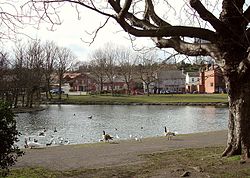Askern
| Askern | |
| Yorkshire West Riding | |
|---|---|
 Askern Spa Pool | |
| Location | |
| Grid reference: | SE5513 |
| Location: | 53°37’0"N, 1°9’-0"W |
| Data | |
| Population: | 5,434 (2001) |
| Post town: | Doncaster |
| Postcode: | DN6 |
| Dialling code: | 01302 |
| Local Government | |
| Council: | Doncaster |
| Parliamentary constituency: |
Doncaster |
Askern is a town in the West Riding of Yorkshire, on the A19 road between Doncaster and Selby. It became a spa town in the late 19th century, but this stopped once coal mines opened in the town. The last mine closed in the 1990s, but the spa days were long gone. It had a population of 5,434 at the 2001 census.
Askern is well known in Yorkshire for its greyhound racing stadium.
History
The earliest record of Askern is from the reign of Edward III. The people of Norton complained to the Sheriff of Osgodcross that the people of Askern had failed to keep part of Askern pool in a clean state. As a result the King's highway had been "overflowed and drowned so that neither horse nor foot passengers could use it".
Askern Spa
The area of the lake and the surrounding wetland area have dominated much of the history starting from the settlements at Sutton Common and continuing through to the Spa of the Victorian era.
Askern, a small farming village, became known locally for its waters in the 18th century when Dr Short, in his book ‘Mineral Waters of Yorkshire’, refers to the waters as having a most unpleasant odour and taste.
During the 19th century Askern started to gain a reputation as having water with healing properties. At this time the lords of the manor built the first bathhouse called Manor Baths. After this other baths were built till in the late 19th century Askern had earned the title of Spa and had 5 bathhouses and the water could also be taken at the Spa Hydropathic Establishment.
Askern came to be the place to stay and the railway was built to enable people from across the Pennines to come and partake of the healing waters. Many people were now coming to Askern by road and rail. Hotels were being built and guesthouses lined Station Road and Moss Road.
Coal Mining
In the early years of the 20th century the quest for coal identified a good seam of coal near Askern. It was decided to access the coal from a mine built above the village and with the mine came the personnel to build it. As the mine opened the New Village was built to house the workers and their families. This new population was at odds with the well to do visitors. As the 1914 war started the death knell was sounded for Askern Spa and the spa visitors declined to no more than a few regulars.
Once again Askern changed direction and became a thriving pit village, which welcomed people from all over the country to work and live in its area, giving the town a mixed background. The mine was regarded as producing highest quality coal and the opening of the Coalite works confirmed Askern as a place of high employment and a pleasant environment to live in. This however changed as the Coalite plant pushed more smoke and fumes into the atmosphere.
Modern day
Following the pit closure, Askern has gentrified once more. Up to a point, it has become part of the Leeds and Doncaster commuter belt because of its location, close to the M62 Motorway and A19 trunk road.
Railway
Askern is on the former Lancashire and Yorkshire Railway line between Doncaster and Wakefield Kirkgate, though Askern railway station closed in 1947 and little remains of it. The line is used mainly by freight services, including coal to Ferrybridge, Eggbrough and Drax power stations, as well as the infrequent passenger services from Bradford Interchange to London King's Cross.